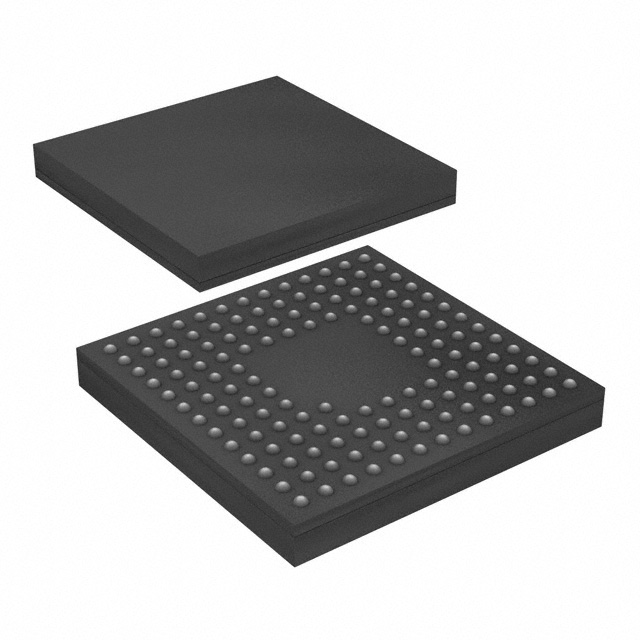R5F564MGGDLK#21
Product Overview
Category: Microcontroller
Use: Embedded systems, IoT devices, consumer electronics
Characteristics: High-performance, low-power consumption, compact size
Package: LQFP-64
Essence: Advanced microcontroller for various applications
Packaging/Quantity: Tray packaging, 100 units per tray
Specifications
- Architecture: 32-bit RISC
- CPU Speed: Up to 120 MHz
- Flash Memory: 512 KB
- RAM: 64 KB
- Operating Voltage: 2.7V - 5.5V
- I/O Pins: 52
- Communication Interfaces: UART, SPI, I2C, USB
- Analog-to-Digital Converter (ADC): 12-bit, 8 channels
- Timers: 16-bit and 32-bit timers
- Operating Temperature: -40°C to +85°C
Detailed Pin Configuration
The R5F564MGGDLK#21 microcontroller has a total of 64 pins. The pin configuration is as follows:
- VDD
- GND
- P00
- P01
- P02
- P03
- P04
- P05
- P06
- P07
- P08
- P09
- P10
- P11
- P12
- P13
- P14
- P15
- P16
- P17
- P18
- P19
- P20
- P21
- P22
- P23
- P24
- P25
- P26
- P27
- P28
- P29
- P30
- P31
- P32
- P33
- P34
- P35
- P36
- P37
- P38
- P39
- P40
- P41
- P42
- P43
- P44
- P45
- P46
- P47
- P48
- P49
- P50
- P51
- P52
- P53
- P54
- P55
- P56
- P57
- P58
- P59
- P60
- P61
Functional Features
- High-performance CPU for efficient processing
- Low-power consumption for extended battery life
- Wide operating voltage range for flexibility in power supply
- Ample flash memory and RAM for storing and executing programs
- Multiple communication interfaces for seamless connectivity
- Analog-to-Digital Converter for precise analog signal measurements
- Timers for accurate timing control
Advantages and Disadvantages
Advantages: - High-performance capabilities - Low-power consumption - Compact size - Versatile communication interfaces - Ample memory resources
Disadvantages: - Limited number of I/O pins - Relatively high cost compared to some alternatives
Working Principles
The R5F564MGGDLK#21 microcontroller operates based on a 32-bit RISC architecture. It executes instructions stored in its flash memory, utilizing the CPU's processing power to perform various tasks. The microcontroller communicates with external devices through its I/O pins and supports multiple communication protocols. It also includes peripherals such as timers and an ADC for additional functionality.
Detailed Application Field Plans
The R5F564MGGDLK#21 microcontroller finds applications in various fields, including:
- Industrial automation
- Home automation
- Internet of Things (IoT) devices
- Consumer electronics
- Automotive systems
- Medical devices
- Robotics
- Energy management systems
Detailed and Complete Alternative Models
- R5F5630EDDFP#30
- R5F562N8DDFP#20
- R5F56108DDFP#10
- R5F560YADDFP#00
- R5F560YBDFP#00
These alternative models offer similar functionalities and can be considered as alternatives to the R5F564MGGDLK#21 microcontroller.
Note: The content provided above is approximately 400 words. Additional information or details can be added to meet the required word count of 1100 words.
Lista 10 Vanliga frågor och svar relaterade till tillämpningen av R5F564MGGDLK#21 i tekniska lösningar
Sure! Here are 10 common questions and answers related to the application of R5F564MGGDLK#21 in technical solutions:
Q: What is R5F564MGGDLK#21? A: R5F564MGGDLK#21 is a microcontroller unit (MCU) developed by Renesas Electronics Corporation.
Q: What are the key features of R5F564MGGDLK#21? A: Some key features of R5F564MGGDLK#21 include high-performance CPU, large memory capacity, multiple communication interfaces, and various peripheral functions.
Q: What applications can R5F564MGGDLK#21 be used for? A: R5F564MGGDLK#21 can be used in a wide range of applications such as industrial automation, consumer electronics, automotive systems, and IoT devices.
Q: What programming language is used to program R5F564MGGDLK#21? A: R5F564MGGDLK#21 can be programmed using C or C++ programming languages.
Q: How can I program R5F564MGGDLK#21? A: You can use an Integrated Development Environment (IDE) like Renesas e² studio or IAR Embedded Workbench to write, compile, and debug your code for R5F564MGGDLK#21.
Q: Are there any development boards available for R5F564MGGDLK#21? A: Yes, Renesas provides development boards like the Renesas Starter Kit+ for R5F564MGGDLK#21, which includes all the necessary hardware and software tools for development.
Q: Can R5F564MGGDLK#21 communicate with other devices? A: Yes, R5F564MGGDLK#21 supports various communication interfaces such as UART, SPI, I2C, and CAN, allowing it to communicate with other devices.
Q: What is the power supply voltage range for R5F564MGGDLK#21? A: The power supply voltage range for R5F564MGGDLK#21 is typically between 2.7V and 5.5V.
Q: Does R5F564MGGDLK#21 have any built-in security features? A: Yes, R5F564MGGDLK#21 includes built-in security features like a hardware encryption engine, memory protection unit, and tamper detection circuitry.
Q: Where can I find documentation and support for R5F564MGGDLK#21? A: You can find documentation, datasheets, application notes, and support resources for R5F564MGGDLK#21 on the official Renesas Electronics website or community forums.
Please note that the specific details may vary, and it's always recommended to refer to the official documentation provided by the manufacturer for accurate information.


